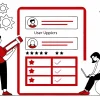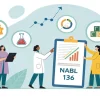
How to Train Staff to Use Real-Time Feedback Systems Effectively?
In today’s fast-paced business world, real-time feedback systems have become essential for fostering transparent communication and enhancing productivity.
Properly training staff to use these systems ensures they can effectively engage with the feedback process. Promoting a culture of continuous improvement.
This comprehensive guide will explore how to train employees to use real-time feedback systems effectively, covering essential techniques, benefits, and strategies for successful implementation.
What Is a Real-Time Feedback System?
A real-time feedback system allows for instant communication and feedback within an organization. Unlike traditional feedback methods that may take weeks or months, these systems enable immediate responses.
Allowing employees to adjust their behaviors and performance in real-time. This immediate exchange fosters a more dynamic and responsive work environment.
Benefits of Real-Time Feedback Systems
Implementing a real-time employee feedback system can significantly improve communication, enhance employee engagement, and accelerate professional development.
By providing timely and constructive feedback, organizations can address issues quickly and prevent them from escalating.
Additionally, these systems support continuous learning and adaptation, which is crucial in a rapidly changing business landscape.
1. Preparing to Train Staff
Preparing to train staff means getting your team ready with the right skills. It’s about helping everyone learn what they need to do their job well. In this guide, we’ll share easy tips to make training effective and useful for your company.
2. Assessing Organizational Needs
Before implementing a real-time employee feedback system, it’s crucial to assess your organization’s specific needs. Understanding the current communication gaps and identifying areas for improvement will help tailor the training to address these issues effectively.
Consider factors like the size of your organization, the existing communication culture, and the technological infrastructure.
3. Choosing the Right Feedback System
Selecting a suitable real-time feedback system is vital. The chosen platform should align with your organizational goals, be user-friendly, and integrate seamlessly with existing tools.
Consider systems with features like anonymity, mobile accessibility, and customizable feedback templates to cater to diverse feedback needs.
Designing an Effective Training Program
Creating a good training program helps boost skills and company growth. This guide will show you how to build a plan that meets your team’s needs and improves results.
1. Setting Clear Objectives
Clearly define the objectives of your training program. These should align with your organizational goals and address the specific areas identified during the assessment phase.
Objectives might include improving communication skills, fostering a feedback culture, or enhancing team collaboration.
2. Developing Training Materials
Create comprehensive training materials that cover all aspects of using the real-time feedback system. These should include user manuals, video tutorials, and FAQs. Make sure the materials are accessible and easy to understand, catering to different learning styles.
3. Incorporating Hands-On Training
Hands-on training is essential for effective learning. Allow employees to practice using the real-time feedback system in a controlled environment before fully implementing it.
This approach helps them become comfortable with the system’s features and functionalities.
Implementing the Training Program
A good training program is key to helping employees grow and succeed. It boosts skills, productivity, and job satisfaction. This guide will show you simple steps to effectively set up and run your training program.
1. Scheduling Training Sessions
Plan and schedule training sessions at convenient times for all employees. Consider offering multiple sessions to accommodate different schedules and ensure everyone can participate. Group sessions can also encourage collaboration and peer learning.
2. Engaging Employees During Training
Engagement is key to successful training. Encourage participation through interactive elements like quizzes, role-playing, and group discussions. Provide real-life scenarios where employees can practice giving and receiving feedback using the system.
3. Providing Ongoing Support
After the initial training, offer continuous support to help employees integrate the real-time feedback system into their daily routines. This support can include follow-up sessions, a dedicated helpdesk, and online resources.
Encourage a culture where employees feel comfortable seeking help and sharing feedback about the system’s use.
Best Practices for Using Real-Time Feedback Systems
Real-time feedback systems are crucial for quick improvements in work and performance. They give instant updates, helping people and teams make fast changes.
This guide will show you the best ways to use these systems to get better results and work more effectively.
1. Promoting a Feedback Culture
Creating a positive feedback culture is crucial for the success of a real-time feedback system. Encourage openness and transparency, emphasizing that feedback is a tool for growth rather than criticism.
Leaders should model giving and receiving feedback constructively, setting the tone for the rest of the organization.
2. Encouraging Constructive Feedback
Train employees to provide feedback that is specific, actionable, and balanced. Constructive feedback should highlight strengths while offering suggestions for improvement. This approach ensures that feedback is received positively and used effectively.
3. Regularly Reviewing and Updating the System
As with any tool, real-time feedback systems require regular reviews and updates. Gather feedback from employees about the system’s functionality and usability.
Use this information to make necessary adjustments and improvements, ensuring the system remains relevant and effective.
Overcoming Challenges in Training Staff
Training staff is very important but can be tough. Challenges like different learning styles and keeping everyone interested can be tricky. This guide will give you simple tips to handle these problems and make your staff training better.
1. Addressing Resistance to Change
Resistance to change is a common challenge when introducing new systems. To overcome this, clearly communicate the benefits of the real-time feedback system and how it can positively impact employees’ work.
Highlight success stories and provide examples of how the system has improved communication and performance in other organizations.
2. Ensuring Technological Readiness
Ensure that all employees have access to the necessary technology and are comfortable using it. Offer additional training for those less familiar with digital tools. Providing adequate technical support can also help ease the transition.
3. Maintaining Consistency Across the Organization
To ensure consistency, establish clear guidelines for using the real-time feedback system. Standardize processes for giving and receiving feedback, and ensure that all employees understand and follow these guidelines.
This uniformity helps maintain a fair and transparent feedback environment.
Measuring the Success of the Training Program
To find out if a training program is successful, you need to check how well participants are doing and how much they’ve improved. This guide will help you use simple methods to measure and improve the impact of your training.
1. Setting Key Performance Indicators (KPIs)
Establish KPIs to measure the success of your training program and the effectiveness of the real-time feedback system. These metrics could include employee engagement levels, the frequency of feedback exchanges, and improvements in performance metrics.
2. Collecting and Analyzing Data
Regularly collect and analyze data to assess the system’s impact. Use surveys, feedback forms, and system analytics to gather insights. This data will help identify areas for improvement and gauge the overall effectiveness of the system.
3. Continuous Improvement
Based on the data collected, continuously refine and improve the training program and the real-time feedback system. Adapt to changing needs and challenges, ensuring the system remains a valuable tool for your organization.
Building a Long-Term Feedback Culture
Building a feedback culture means making feedback a regular and important part of work. It helps everyone grow, improves communication, and keeps the team moving forward.
1. Integrating Feedback Into Daily Operations
To embed feedback into the organizational culture, integrate it into daily operations. Encourage regular feedback exchanges, making it a routine part of meetings and project debriefs.
This integration helps normalize the feedback process and reinforces its importance.
2. Recognizing and Rewarding Positive Feedback Practices
Recognize and reward employees who actively participate in the feedback process and demonstrate positive feedback practices.
This recognition can motivate others to engage with the system and contribute to a supportive and collaborative work environment.
3. Encouraging Peer-to-Peer Feedback
Promote peer-to-peer feedback as a way to build stronger teams and foster mutual respect. Encourage employees to seek and provide feedback among colleagues, creating a more inclusive and balanced feedback culture.
Conclusion
Training staff to use real-time feedback systems effectively is a crucial step in enhancing communication and driving organizational success. By carefully assessing needs and choosing the right system.
By implementing a comprehensive training program, organizations can create a dynamic feedback culture that supports continuous improvement.
Overcoming challenges, measuring success, and continuously refining the process ensure that real-time feedback systems remain valuable tools for fostering growth and engagement.
Frequently Asked Questions
How Can I Motivate Employees To Use The Real-Time Feedback System?
Motivate employees by highlighting the system’s benefits, providing comprehensive training, and recognizing those who actively participate.
What If Employees Are Resistant To Using The Real-Time Feedback System?
Address resistance by clearly communicating the system’s benefits and providing ample support during the transition. Offer additional training for those unfamiliar with digital tools and emphasize how the system can improve their work experience
How Do I Ensure Feedback Is Constructive And Well-Received?
Train employees to provide specific, actionable, and balanced feedback. Encourage them to highlight strengths and offer constructive suggestions for improvement. Promote a culture where feedback is seen as a tool for growth rather than criticism.
How Often Should We Review And Update The Real-Time Feedback System?
Regularly review the system based on employee feedback and system analytics. This review should occur at least annually, but more frequent assessments may be necessary, depending on the organization’s needs and changes in technology.
Can Real-Time Feedback Systems Be Integrated With Other Tools?
Yes, many real-time feedback systems can be integrated with other tools, such as HR systems and communication platforms. Integration helps streamline processes and makes it easier for employees to access and use the feedback system.
What Are Some Common Challenges When Implementing Real-Time Feedback Systems?
Common challenges include resistance to change, technological readiness, and maintaining consistency. Addressing these challenges requires clear communication, comprehensive training, and ongoing support.
Enhance Patient Care and NABH Compliance with LazyMonkey
LazyMonkey is your all-in-one solution for improving patient care, retaining more patients, and meeting NABH standards. Our powerful QR-based feedback tool enables you to capture real-time insights from patient feedback, discharge surveys, staff and doctor evaluations, and clinical research, while also streamlining inter-departmental communication.
Transform your healthcare facility today - reach out to us at hello@lazymonkey.in, or request a demo here!
Elevate Your Restaurant Experience with LazyMonkey
LazyMonkey’s QR-based feedback system helps you gather real-time insights from customers, track satisfaction levels, and enhance the dining experience. Get instant feedback on your menu, service, and ambience, and make data-driven improvements to boost repeat customers and reviews.
Improve your restaurant today – reach out to us at hello@lazymonkey.in, or request a demo here!
Empower Student Engagement and Campus Improvement with LazyMonkey
LazyMonkey offers a seamless way to gather student feedback, track satisfaction, and enhance campus life. From course evaluations to dorm feedback, our QR-based solution makes it easy to capture valuable insights and improve student retention.
Upgrade your university experience – contact us at hello@lazymonkey.in, or request a demo here!
Streamline Feedback and Drive Performance Across Your Enterprise/Franchise with LazyMonkey
Whether you manage one or multiple locations, LazyMonkey’s QR-based feedback system helps you gather real-time employee and customer feedback. Improve operational efficiency, track satisfaction, and make data-driven decisions to enhance brand consistency and growth.
Transform your franchise today – reach out to us at hello@lazymonkey.in, or request a demo here!
Enhance Customer Satisfaction and Service Standards in Banking with LazyMonkey
LazyMonkey empowers banks to capture real-time feedback from clients across branches. Improve customer experience, assess service quality, and ensure regulatory compliance with our QR-based solution, helping you retain clients and meet banking standards.
Elevate your bank’s customer care – contact us at hello@lazymonkey.in, or request a demo here!
Boost Customer Engagement and Mall Satisfaction with LazyMonkey
LazyMonkey’s QR-based feedback tool enables you to collect feedback from shoppers, track satisfaction, and enhance the mall experience. Gather insights on store services, cleanliness, and entertainment to create an unmatched customer journey.














